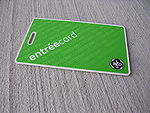- Datacard
-
Datacard is a card which contains data or which is used for data operations (transfer, transformation, input, output).
Contents
Datacard types
Datacards can be sorted by their purposes:
- Expansion card – printed-circuit board which is inserted in special slot in the device and used to add functions to this device;
- Memory card or flash card is a card which is inserted into the corresponding device socket and used for data storage and transmission;
- Identification card is a card that works by the contact/contactless interface and contains the data used for performance of various functions, for example, entry access control in subway or offices. It is also used for prepaid service, banking, telecom, etc.;
- Datacard or "electronic card" is a geographical, climatic, road, topographical or another card displayed on the video screen of any device (computer or GPS-navigator) or represented otherwise to be more convenient to use in a certain situation (for example, navigator’s vocal instructions).
Expansion cards
The expansion card in the computer is equipped with contacts on one of its edges equipped which precisely correspond to the motherboard slot socket. Contacts provide electric connection between card and motherboard components.
There are various types of expansion cards:
- videocard is a device that reformates image from computer memory into the video signal for the monitor, videocard has her own microprocessor, relieving the central processor of the computer;
- sound card, allows to work with sound;
- network card is a printed-circuit board, that enables computers’ interaction by local network.
Memory cards
Many modern devices demand a bulk of non-volatile memory with low power. Flash memory is used for these purposes. It widespread in digital portable devices — a photo and video cameras, dictaphones, MP3 players, a handheld computer, mobile phones, and also in smart phones and communicators. Besides, it is used for storage of the built-in software in various devices (routers, mini-phonestations, printers, scanners, modems) and various controllers.
Also in recent years USB flash-drives are becoming more and more popular and have almost forced out diskettes and CD disks. Flash-memory is a most known for application in USB flash-drives. The NAND-type of memory which is connected through USB interface (USB mass storage device) is basically applied.
Flash cards also are based on flash-memory, such as Secure Digital (SD) and Memory Stick which are actively applied in the portable devices (cameras, mobile phones). Flash-memory occupies the biggest part of the portable data device market.
Identification cards
- Contact cards with ISO 7816 interface
Contact smart cards (cards with chip) have a contact zone, which consists of a few small contact petals. When the card is inserted into the input reader, the chip adjoins with electric connectors and the input reader can read and write down the chip information. Standard ISO/IEC 7816 also regulates exchange reports and some aspects of work with the other smart cards data.
Such cards are used for the holder authorization for reception of any services (the bank account access for payments realization, use of the prepaid mobile services, etc.)
The most widespread contact smart cards are SIM cards, payphone cards, some banking cards.
- Contact cards with USB interface
Often it is a microcircuit, such as a SIM card segregated from the ISO 7816 card and inserted in tiny case with reader and USB slot. It makes smart-card application for computer authentification much more conveniently.
For example, an electronic key, or eToken which is a personal authentification tool and the protected data storage device, that supports work with digital certificates and with an electronic digital signature.
- Contactless cards
They are smart cards that communicate with the reader through RFID (Radio Frequency IDentification) technology. The card must be close enough to the reader to perform necessary operations. RFID are often applied in areas where operations must be performed quickly, for example, in public transport.
There are many examples of contactless smart cards, such as travel ticket in underground and ground transport, the electronic ("biometric") passports, some kinds of cards in access monitoring systems.
Electronic cards
Electronic card is a program-controlled cartographical image visualized with the use of programs and technical facilities in a projection accepted for cards and system of conventional signs. Electronic card is constructed on the basis of the digital cards data or databases of geographical information systems (GIS).
Digital topographic geodesic electronic cards can be represented by:
- Raster electronic plan is an electronic plan, its cartographic information is presented by the matrix, the matrix’s elements are codes of the cartographical image colors. Raster electronic plans are created by traditional topographical materials scanning or vector digital district models rasterization. Raster materials can be black-and-white, gray-scale and color. The basic characteristic of the raster image is its density measured usually in dots per inch (dpi).
- Vector electronic plan – the electronic plan (cards), its cartographical information is presented by the sequence of vectors. The semantic information at vector electronic plans can be not defined (be absent). Vector electronic plans are created on the basis of the automated methods (information transfer from geodetic devices’ electronic stores) or by the graphic representation of traditional plans scanning and their subsequent vectoring.
Categories:- Computer buses
- Solid-state computer storage media
Wikimedia Foundation. 2010.




